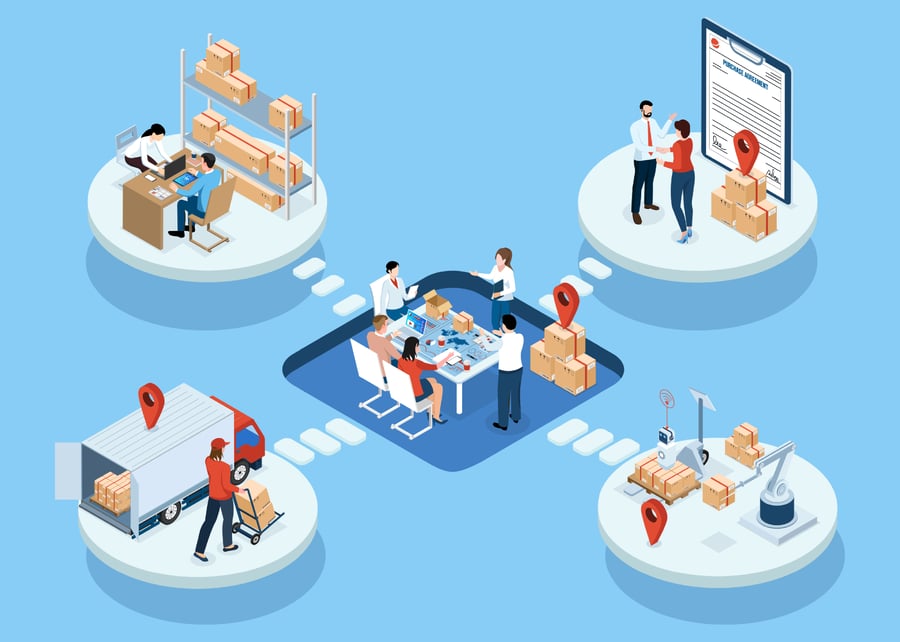With over 15 years of experience in finance, risk management and data analytics, Bill understands exactly what enterprise businesses should be thinking about as they build their corporate growth and risk strategies. Prior to joining Creditsafe in 2021, he spent six years at Dun & Bradstreet as Area Vice President of Finance Solutions and Third-Party Risk & Compliance.
Want to learn about the role and value of AI in supply chain management?
Supply chain management is a huge part of what keeps your business moving. And all it takes is one small misstep for things to get held up.
Traditionally, the supply chain would have been entirely managed by humans. But in a world of consumerism where we expect anything and everything to be done instantly, more and more companies are adding technology to their supply chain.
In recent years, the addition of artificial intelligence (AI) to supply chain management has become increasingly common. And it’s easy to see why since AI can speed up decision-making, improve operational efficiencies, save money and so much more.
Understanding AI’s role in supply chain management

Traditionally, when you hear the words ‘supply chain management,’ you might think of a factory. But these aren’t the only types of businesses with a supply chain. All companies have a supply chain.
The key role of AI in supply chain management is optimization. It’s not uncommon for businesses to experience delays in their supply chain. And when this happens, it can really hold the entire business up. Traditionally, businesses would have certain areas of their supply chain that would experience bottlenecks, which would disrupt workflows, reduce productivity of the workers and cause delays (and even stoppages) in the supply chain. Thankfully, AI can help prevent these bottlenecks.
Take car insurance companies, for example. When you apply for car insurance online, you’ll be asked to input all sorts of data about yourself - from your name and address to the amount of time you have been driving and any traffic violations you have on your record. From this data, the system will decide if you’re suitable for the insurance company and give you a price quote. When you do this, there isn’t a person sitting on the other side of the computer giving you a quote. Instead, this is done by AI, using an algorithm to determine your risk level and setting a price that takes that risk level into consideration.
The pandemic drove up demand for business loans
The COVID-19 pandemic has had a tumultuous effect on businesses, driving up demand for business loans in the last few years. These loans were sought for many reasons, such as covering operating expenses, refinancing or paying down debt, expanding into new markets and exploring new opportunities. Whatever the reasons for applying for a loan, the sad fact is that more than 80% of loan applications are denied.

What’s causing so many business loan applications to be denied? We’ll tell you.
Poor business credit score
Limited cash flow
Multiple changes on business credit report in short period of time
High debt
Too many applications
Unfortunately, if you receive repeated late payments, it can limit your own company’s cash flow and make it tough for you to pay your own suppliers and vendors. If that happens, then you could easily find yourself in a situation where you’re making late payments repeatedly, which could hurt your business credit score. And as I mentioned above, a poor business credit score could be seen as a red flag if you’re trying to get approved for a business loan or seeking alternative funding.
Now if you aren’t regularly monitoring your own company’s credit report, you could be unaware of changes being made to your credit report that could hurt your business credit score. If there are changes made but they’re inaccurate or have been resolved recently, you’ll want to make sure to notify the appropriate lenders so that these changes are no longer showing up on your business credit report. That will help improve your business credit score.
Faster credit risk decisions mean a more reliable supply chain
When it comes to your supply chain, you’ll likely be hiring vendors and suppliers to provide valuable services. And you’ll also be taking on new customers and looking to grow your business with existing customers.
This is where AI can be extremely valuable because it can take on the work of doing due diligence on potential customers - checking to see if they’re low or high risk, how much debt they have, what their business credit score is and if they have any derogatory marks - and then using all that data to provide a ‘yes/no’ decision on whether you should bring them on as a customer. Not only does this take out the manual work of reviewing inordinate amounts of credit risk data, but it also reduces your financial, legal and compliance risks.
By using credit risk intelligence software, you can speed up the decision process for bringing on new customers, while also improving the onboarding process. This type of software makes it easy for you to set up specific parameters that matter to your business so that you can get decisions in a matter of seconds. This also means that your business operations can run smoothly and effectively because you’ve been able to bring on the necessary suppliers to fulfill your customers’ orders.
Why an AI-powered supply chain is a no-brainer
AI has become increasingly valuable to businesses because of the visibility and monitoring capabilities it provides. By doing so, it can reduce your logistics expenses, improve your inventory tracking and increase your customer satisfaction.
Using AI in your supply chain can provide real-time analytics, which can help you determine how and when to interact with your customers to improve the customer experience. Plus, it can tell you which areas/departments are operating most and least efficiently so you can make more informed decisions about where to invest your budget or cut back on resources.
Of course, there are quite a few benefits of using AI in your supply chain. We’ll cover off on a few.

Demand planning and scenario mapping
The beauty of AI is that it can show clear patterns in consumption habits and even predict seasonal demand, which could help prevent overstocking unnecessary items. That will save you quite a bit of money in having to store excess stock in warehouses and losing money on stock that doesn’t get sold.
Given how volatile the economy is, coupled with rising inflation and the cost of living crisis across the US, demand planning and scenario mapping are more important than ever if you want to build a more efficient, reliable and resilient supply chain. This isn’t just lip service; it’s a fact. According to McKinsey, we can expect a disruption to the supply chain lasting more than one month every 3.7 years.
Network optimization
Machine learning and AI can give you insight into where exactly to store your inventory so you can increase the speed of your delivery without increasing final mile delivery costs.
On-time delivery predictions
One of the biggest complaints customers have when buying products online is the delivery service. Deliveries go to the wrong address. Wrong items get shipped. Items are either damaged or broken completely. None of these problems are ideal and can make customers feel more than frustrated with a business. If delivery problems happen frequently with the same business and show no signs of improvement, you can bet a customer will ditch that business and buy from another one.
AI can help your business get in front of a possibly delayed shipment so you can let your customer know. Don’t underestimate the value of on-time deliveries - it can have a real effect on your customers’ loyalty.

About the Author
Bill James